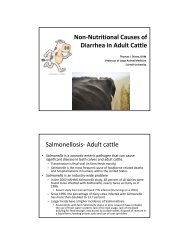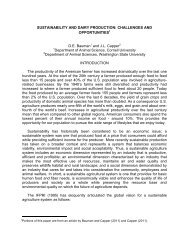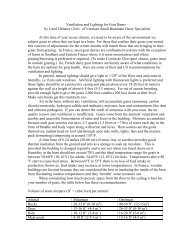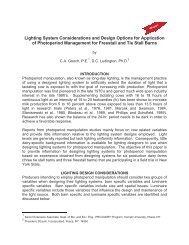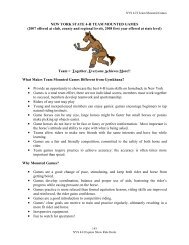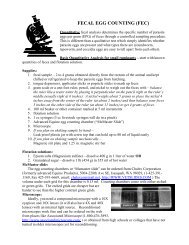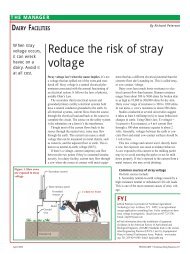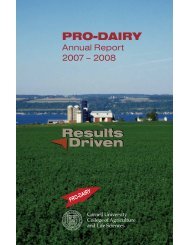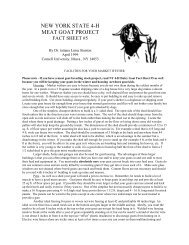2009 Proceedings of the Cornell Nutrition Conference For Feed ...
2009 Proceedings of the Cornell Nutrition Conference For Feed ...
2009 Proceedings of the Cornell Nutrition Conference For Feed ...
Create successful ePaper yourself
Turn your PDF publications into a flip-book with our unique Google optimized e-Paper software.
experiment that corresponds to <strong>the</strong> “fixed” level <strong>of</strong> Met in MP, 4) calculating “production<br />
responses” (plus and minus values) for control and treatment groups relative to <strong>the</strong><br />
“reference production values”, and 5) regressing <strong>the</strong> production responses on <strong>the</strong><br />
predicted concentrations <strong>of</strong> Lys and Met in MP.<br />
The “revised” dose-response plots that relate changes in milk protein concentrations<br />
to changes in predicted concentrations <strong>of</strong> Lys and Met in MP for <strong>the</strong> NRC (2001) model<br />
are presented in Figure 1. While <strong>the</strong> plots are strikingly similar to those published in<br />
NRC (2001), <strong>the</strong>re are differences between <strong>the</strong> “published” and “revised” breakpoint<br />
estimates for <strong>the</strong> required concentrations <strong>of</strong> Lys and Met in MP for maximal content <strong>of</strong><br />
milk <strong>of</strong> milk protein. The breakpoint estimates for <strong>the</strong> required concentrations <strong>of</strong> Lys and<br />
Met in MP for maximal content <strong>of</strong> milk protein were 6.80 and 2.29%, respectively (see<br />
figure legends), slightly lower than <strong>the</strong> values <strong>of</strong> 7.24 and 2.38% reported in NRC<br />
(2001). The breakpoint estimates for <strong>the</strong> required concentrations <strong>of</strong> Lys and Met in MP<br />
for maximal yield <strong>of</strong> milk protein were 7.10 and 2.52%, respectively (plots not shown).<br />
These values are also different from <strong>the</strong> NRC (2001) values <strong>of</strong> 7.08 and 2.38%. It was<br />
concluded by Schwab et al. (<strong>2009</strong>), from a comparison <strong>of</strong> <strong>the</strong> predicted flows <strong>of</strong><br />
microbial MP and feed MP with <strong>the</strong> beta and final versions <strong>of</strong> <strong>the</strong> two models, along with<br />
a re-examination <strong>of</strong> feed inputs, that <strong>the</strong> primary reason for <strong>the</strong> differences in breakpoint<br />
estimates was differences in feed inputs for some <strong>of</strong> <strong>the</strong> studies. It is suggested that<br />
<strong>the</strong> new values be used as <strong>the</strong> reference values when using <strong>the</strong> NRC (2001) model to<br />
optimize Lys and Met concentrations in MP for lactating cows.<br />
DEVELOPMENT OF LYS AND MET DOSE-RESPONSE PLOTS FOR CPM-DAIRY<br />
(V.3.0.10) AND AMTS.CATTLE (V.2.1.1)<br />
Recognizing that <strong>the</strong> indirect dose-response approach for identifying optimal<br />
concentrations <strong>of</strong> Lys and Met in MP had not been extended to o<strong>the</strong>r models,<br />
Whitehouse et al. (<strong>2009</strong>) repeated <strong>the</strong> same steps, using <strong>the</strong> same studies as used for<br />
NRC (2001), to generate Lys and Met dose-response plots for CPM-Dairy and<br />
AMTS.Cattle. Because ration formulation and diet evaluation programs differ in <strong>the</strong><br />
approach and assumptions taken to estimate AA supply, it was expected that estimated<br />
“requirements” for Lys and Met in MP would be different from those for NRC (2001).<br />
The resulting dose-response plots that relate changes in milk protein concentrations<br />
to changes in predicted concentrations <strong>of</strong> Lys and Met in MP for CPM-Dairy and<br />
AMTS.Cattle are presented in Figures 2 and 3, respectively. As noted in Figures 1-3<br />
and Table 1, differences existed among <strong>the</strong> three models in <strong>the</strong> breakpoint estimates for<br />
<strong>the</strong> required concentrations <strong>of</strong> Lys and Met in MP for maximal content and yield <strong>of</strong> milk<br />
protein. This was expected, as models differ in <strong>the</strong> approach for predicting supplies <strong>of</strong><br />
AA. These differences lead to differences in predicted supplies <strong>of</strong> RDP, RUP, MP and<br />
MP-AA (Whitehouse et al., <strong>2009</strong>). The AA prediction model in NRC (2001) is semifactorial<br />
in nature, where some <strong>of</strong> <strong>the</strong> parameters are determined by regression. In<br />
contrast, CPM-Dairy and AMTS.Cattle use factorial approaches for predicting AA flows<br />
3



